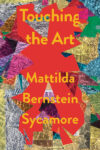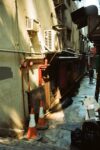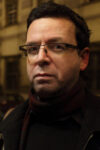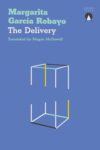Author of articles and essays in The New York Times, Los Angeles Times, Wall Street Journal, The Guardian, GQ, Esquire, Salon, and Slate, Rosecrans Baldwin has published the novels You Lost Me There (2010) and The Last Kid Left (2017), and the nonfiction titles Paris, I Love You but You’re Bringing Me Down (2012) and his newest release Everything Now: Lessons from the City-State of Los Angeles, published by MCD/FSG. It’s replete with cultists, wildfires, earthquake lore, working-class thespians, DIY survivalists, Border Angels, gamer collectives, labor trafficking survivors, and assorted Angelenos who could be said to be vagabonds (or wastrels). Despite reckoning with a litany of contemporary apocalypses, it remains a book levied with humor, including an inventive appropriation of Charles Bukowski’s character Henry Chinaski, an exposé of the lampoonable greed of investment trusts that view human suffering as a once-in-a-lifetime opportunity to “buy low,” and a hilarious depiction of a screenwriting team’s meeting with Hollywood producers gone awry.
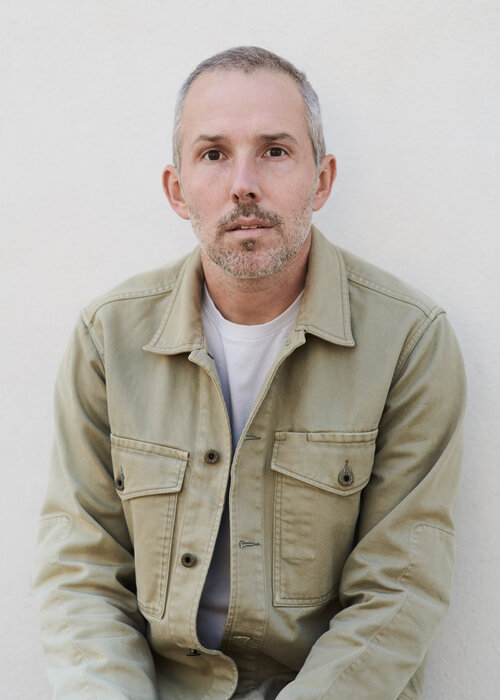
Sean Hooks: Let’s start with the dystopian aspects of Los Angeles: Erewhons and Whole Foods abutting massive homeless encampments, the Stepford Wives quality of planned communities like Lakewood, Panorama City, and Irvine (not to mention Playa Vista and the sprawling techno-plutocracy of Silicon Beach), The Atlantic reporting that schools in neighborhoods like Santa Monica and Beverly Hills have vaccination rates (for traditional vaccines) as low as Chad and South Sudan, and of course the noxious air quality hovering over low-wage serfs who scry the city’s sci-fi-like post-Covid quadrants to deliver squiring and food services to their modern-day feudalist lords. Near the end of your book, you state that “depictions continue to be overly optimistic or pessimistic” and quote local columnist Steve Lopez on how L.A. is “in greater need of critics than defenders.” While Everything Now eschews easy responses by etching a series of persuasive and diverse engravings of the city-state, I’d wager that most who ingest the whole of your text will say that the negatives seem to outweigh the positives. Is this a fair reading?
Rosecrans Baldwin: I think it’s fair. I don’t know if the moral universe bends to justice, but I try to take the long view on most things. At the same time, it’s a grind when it seems like every overpass within a hundred miles of where I live includes an encampment. Some of Los Angeles’s biggest problems are in plain view: housing, mental illness, drug addiction, environmental blight. And some problems are harder to detect: income inequality, racism, our prisons and law enforcement, our educational failures. Los Angeles is full of fissures. People fall through the cracks constantly. At the same time, at least for the moment, I’m not interested in living anywhere else, at least not in the United States. There’s just so much here to fight for, to relish, to keep you on your toes. I was talking to the painter Friedrich Kunath recently and he made the point that Los Angeles is a broken promise, an unfulfilled promise, but that just means there’s an opportunity to fix it, to fill it, and I thought that was pretty good.
I’m interested in your book’s title and framing. A city-state is a particular way that homo sapiens organize themselves, different from a cosmopolis, megalopolis, conurbation, or metroplex. Wikipedia notes that “unlike most metropolitan areas, regional identity remains a contentious issue in the Greater Los Angeles area, with many residents not acknowledging any association with the region as a whole.” One of your interview subjects, deputy city manager in Lakewood turned author D.J. Waldie, says: “People who live here make a distinction between the municipal boundaries of the City of Los Angeles and the bigger thing called L.A., which extends into Orange County, out almost into the desert. We know we live in L.A., but we also know we don’t live in Los Angeles.” And you and I could talk endlessly about economic fragmentation, the permutations of class and gentrification (a la historian Mike Davis, one of the surfeit of sources you draw from, and the one most singularly close to a spirit animal, I’d argue), and the various regional distinctions — The OC, Long Beach, Pasadena, DTLA, Venice, Inglewood — but I most want to hear how you perceive the post-Covid, post-Biden scene and allow you to start by speaking to L.A.’s present incarnation and its evolving reputation in the hyper-present “now” alluded to in this book’s title.
The city-state model works best for me as a frame of understanding L.A. because it addresses size and scope and the feudal class structure, that sense of shared feeling and stressors and destiny, no matter the kaleidoscopic diversity of humans and built environment. But the model is more metaphor than fact; Los Angeles is still a city in the United States. And yet that doesn’t sit quite right in my understanding, factually, especially when I drive around and talk to people.
To your point about Waldie’s comment, it’s funny, there’s a moment in Los Angeles Plays Itself, Thom Andersen’s great film about L.A.’s role in the movies, where Andersen talks about (if I’m remembering this correctly) disliking the term “L.A.” in lieu of “Los Angeles.” That the diminutive is belittling, silly, more branding than true identity. And I used to agree with him, but I think I’ve come around, I kind of love it as the best name — as Waldie alludes to — to describe the great morass that is the many counties’ spread. It’s certainly better than “The Southland.”
I don’t know yet what post-Covid L.A. will look like, of course, but Covid-era Los Angeles has felt and feels very city-state-like to me. The wealthy (and healthy) serviced by the non-wealthy (and exposed). The image of Garcetti’s face on our televisions, on the giant video billboards at Dodger Stadium’s testing/vaccination site, while his ministers and the county supervisors mix their messaging. We’re still too close to the pandemic to know L.A.’s experience in bigger terms than case counts and deaths and nurses’ testimonials, but we’ll have it soon.
With the region’s wildfires as regular events, as the ever-looming “Big One” earthquake remains as overdue as a presidential assassination, with a public school system “where around 80 percent of children enrolled in the LAUSD lived below the poverty line,” and as crime rates rise in the aftermath of the pandemic, I feel compelled to ask you something people have certainly been asking me, even more so as the post-lockdowns/quarantines exodus from the state of California continues: How do you justify staying here?
Because I love it. Los Angeles is a rough draft. As a person, I’m a rough draft. I mean, I definitely have ups and downs with living here. The house we rent sits on ground that supposedly will turn molten if a nearby fault erupts; I try not to think about that. And I understand what there is to hate about Los Angeles. But I also think some people can be selfish with the city, expect it to meet an idea of what it should be, rather than look at it as it is. Los Angeles isn’t going to ask you to the prom. And it’s a terrible place to visit as a tourist. But to live here, to court the city, to really engage, can be quite rewarding.
There’s something I address in the book that’s part of why I wrote it in the first place, which maybe comes back to that “rough draft” thing. I feel at home here. Only a couple weeks after arriving, I felt like I was where I belonged, possibly for the first time in my life. I don’t know exactly why that is, but I think it’s partly to do with feeling like an outsider. L.A. is an outsider town. If you didn’t quite fit where you started, you can start over here. That’s different from New York City. New York is an insider town, a city for people who are insiders, or who aspire to be insiders, whether in business, finance, art, publishing. Los Angeles puts out a different draw.
Your rhetoric about the subject of L.A. as nationwide epicenter of homelessness, ranging from journalistic reportage at downtown’s Skid Row to things observed right outside your own door — “Pool of diarrhea on the doorstep. Narcotics confetti everywhere…People openly shooting up on the corner…The junkie-looking guy who told our neighbor exactly how he intended to rape her” — is pretty damning. This was a major crisis prior to the Covid-incepted economic shutdown and has become increasingly more noticeable since. Its insolvability and pervasiveness make the word “daunting” feel rather insufficient. Is houselessness our city’s most insurmountable obstacle?
No. Expert after expert told me, and I want to say that the research on this holds up, that the housing crisis — which is tied in with mental health, addiction, justice reform — is surmountable. It’s solvable. At the same time, we need to want to solve it. And not enough people want to solve it, I don’t think. If it’s not happening to them, if a relative is not in the streets, lots of people don’t care. Maybe somebody has done the math that says if X amount of people are unhoused, then Y amount of people will be concerned — and we haven’t reached X yet. You would think that 60,000-plus people unhoused would be sufficient, but humans struggle with big numbers, as the Covid pandemic has painfully shown.
Big picture, human beings age and die. Along the way, we tend to inertia. And it’s easy to be afraid. At the same time, I’m less afraid of somebody camping under an overpass, trying to score, trying just to eke out another day, than somebody living in Bel Air or Simi Valley, who comes to believe they’re losing status in the world and decides they need to do something about it. Those people terrify me.
To move into the less misanthropic dominion of art as challenging but not inherently discomfiting, I want to ask about your esoteric publishing history. You’ve released a gallimaufry of works both fictional and nonfictional, and you co-founded a major online publication, The Morning News (with Andrew Womack), that’s been extant and thriving for over two decades. In a country that often proselytizes on behalf of specialization, I for one find hybridists and generalist raconteurs an ever more captivating and adaptive group of figures. Do you see your writerly self as an eclectic one, what some might call “restless,” or what in another era may have been called a “seeker”?
I could see those terms being used. I don’t really know how I’d characterize myself. I’m sort of a mule, head down, trudging in my track, and sometimes the track is fiction, sometimes it’s nonfiction, sometimes it’s something else.
When I was in my twenties, I wanted to do it my way, whatever that meant. I didn’t train in fiction writing or journalism. College was four years of studying and writing poetry. I didn’t go to graduate school. I’ve always admired writers who appear to write for themselves — questions they find interesting, things about life they find confusing — but in a way that still appeals to a broad audience, whatever the medium. And I love it when novelists write nonfiction and memoir (because sometimes it’s better than their fiction). Zadie Smith is a profound essayist. Denis Johnson’s nonfiction moves me. Maybe it’s about motivation, desire. I would say I’m often driven by puzzles about the ways people behave, and that leads me to fiction; or specific people or groups of people who I find fascinating, and that leads to nonfiction; and day-to-day life stuff, the grocery lists, the daily grist, which goes into poetry, correspondence, therapy, what have you. Probably the only forms I’m not attracted to are short stories and Twitter.
Everything Now can be classified as a bric-a-brac text engaged in aspects of collage and pastiche (sections of it were previously published as standalone articles in GQ and parts feature literary quotation from myriad sources), but in other ways it can be read as highly patterned and unified (it certainly qualifies as a space-and-place narrative and as urban mythology). I’ve seen you describe the book as a “weird work of creative nonfiction,” a denotation that bundles together strains of postmodernism, investigative reportage, and what writers such as Tom McCarthy and Elvia Wilk have dubbed “the new weird,” while reminding me with its immersive new-journalistic verve that 2021 is the 50th anniversary of Hunter Thompson’s Fear and Loathing in Las Vegas. You even splice in moments of highly crafted literary prose, particularly in your descriptions, with lines like “the general mood was buoyant dread” and a definition of the city as “an exercise in horror vacui…algae from the future…Los Angeles ate the dream side of my mind.” How do you think of this work in terms of genre, form, literary categorization?
The form comes from an idea I’d had years ago, that I wanted to structure a book like Ludwig Wittgenstein’s Tractatus. Pretty much his only book, it’s a work of philosophy with a pretty weird structure. Basically, it’s seven (short) chapters and each chapter is headlined by a statement, a proposition that tries to explain something about the relationship between language and the world. Then, the chapter is divvied up into subchapters, or sub-statements — for chapter 1, it would go 1.0., 1.1, 1.2, 1.3 — with each of these secondary items being another statement or passage that comments or elaborates on the one or ones that come before it. Each chapter then begins to accumulate a greater sense of meaning and nuance. So, that’s where my idea of “lessons” came from. I’m no social scientist, and I’m more of a novelist than anything, but I had the notion that if you look and listen closely and long enough, certain truths or statements might emerge, drawn from the lives that I was observing and researching, that would propose something about the nature of life in the city-state of Los Angeles (In fact, early drafts of the book used the term “propositions” instead of “lessons,” but I decided that sounded too academic). That’s why the chapters begin with a single human story, a life to begin to illustrate something about L.A., and then the narrative skitters off in other directions — other human stories, sets of facts, ways that other writers have described life here — to increase resonance.
In terms of inspiration, there are tons of books about Los Angeles that inspired me — Mike Davis, Lynell George, Joan Didion, many more. Some of the biggest inspirations for the book were more tangential. Maximum City: Bombay Lost and Found by Suketu Mehta is probably the closest analogue. Orhan Pamuk’s Istanbul: Memories and the City was mind-opening in key ways.
Let’s conclude with a triptych of morsels:
- Most underrated piece of Los Angeles literature? (however you choose to define that; mine is John Haskell’s ingenious 2009 novel Out of My Skin)
Sudden Rain by Maritta Wolff. Mean by Myriam Gurba. The Barbarian Nurseries by Héctor Tobar. City of God by Gil Cuadros. The list goes on. Southern California: An Island on the Land by Carey McWilliams isn’t underrated but it should be better known to the non-academic audience, that book is a treat.
- Your favorite LA-area museum, gallery, or art space?
The Huntington. For the gardens, the restaurant at lunch, the atmosphere, the otherworldliness. A beautiful place to visit and be quiet.
- OK, we’ll close with the toughest question yet: Who’s got the best tacos in the city-state?
Impossible. They’re too numerous. It all depends on what you’re in the mood for, what you crave, which truck is closest. The best taco is the taco not yet tasted. Something like that.
Sean Hooks was born and raised in New Jersey. He holds a BA from Drew University, an MFA from the University of Nevada, Las Vegas, and an MA from Loyola Marymount University. Presently, he resides in Los Angeles. He has published fiction, essays, reviews, articles, and interviews in various venues. His website is www.seanhooks.com.
This post may contain affiliate links.




